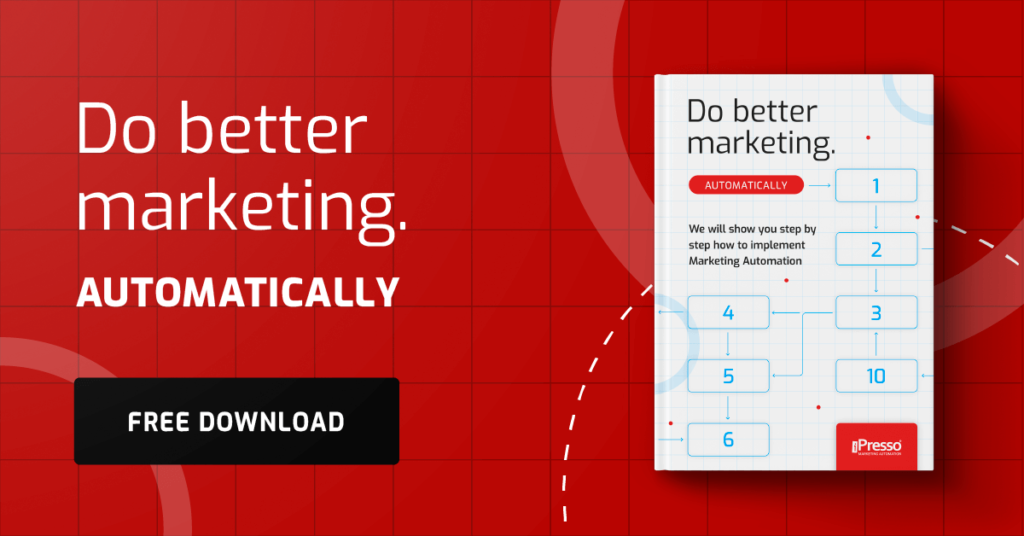How to make sales finally love marketing? The answer: Contact scoring in iPresso. Here’s how to do it step by step

Sales and marketing are like cats and dogs – sometimes they get along, and sometimes they look at each other like aliens. But is there a way to get these two departments to finally start speaking the same language? Of course there is! It’s time to learn about contact scoring.
Why are there no sales despite numerous marketing campaigns?
The problem is simple. Marketing campaigns do not guarantee good quality leads. Of course, there are several measures that can be taken to improve the quality of the contacts acquired, such as creating a persona, i.e., an ideal customer, in advance and preparing an offer that specifically meets their need. The marketing department can generate many leads per month, but the people who clicked on the link or viewed the ad may not have any plans to use the services. This is where scoring comes in – a points system that will identify the potential customers most interested in your offer.
Scoring is not rocket science
The system automatically assigns points to contacts based on their interactions, behaviors, and activities. In practice, this means that iPresso tracks every move made by users of your website. Did someone visit the pricing page? They get 10 points. Did they download an e-book? They get 15 points. Did they sign up for a webinar? That’s 25 points. The system automatically counts and knows which contact is hot and which still needs some encouragement.
In iPresso, you can assign points based on demographic criteria (position, company size, industry – each feature has its own point value) and behavioral criteria. Behavioral scoring looks at what the contact is doing. It involves evaluating contacts based on their activity within the monitored pages and their response to sent messages.
How to set up scoring that works?
Before you start handing out points left and right, think about the customer journey. Which actions indicate greater interest? Is someone who has read a blog as valuable as someone who has checked the price list twice?
Create a map of activities from least to most valuable, for example:
- Visiting the home page: 5 points.
- Reading an article: 10 points.
- Visiting the pricing page: 15 points.
- Filling out the contact form: 30 points.
Not every customer is your number one target. If you sell software to large companies, the CEO of a startup with five employees may be less valuable than a manager at a corporation with 200 employees. The iPresso system allows you to implement your own plans and scoring rules.
iPresso also allows you to set negative points. For example, a recipient will receive 20 negative points for unsubscribing from a newsletter and 5 negative points for not reading an email within 24 hours. This way, the sales department can focus only on people who are genuinely interested in the services.
Practical examples – scoring in various industries
In an online store, scoring may look as follows:
- Adding a product to the cart: 30 points.
- Browsing product reviews: 10 points.
- Comparing products: 25 points.
- Starting the payment process: 50 points.
- Abandoning the cart: minus 30 points.
For a VOD content distributor running its own streaming platform, you can award points for, for example:
- Monthly subscription fee: 40 points.
- Renewing the subscription for a year: 60 points.
- Purchase of an additional movie package: 25 points.
In the FMCG industry, points will be awarded for other activities:
- Downloading the app: 30 points.
- Reaching the gold level in the loyalty program: 60 points.
- Unsubscribing from the newsletter and advertising brochures: minus 25 points.
The most common scoring mistakes (and how to avoid them):
- Scoring only makes sense if sales uses it. If the points don’t go to the CRM, the sales team won’t see them. In iPresso, integration with popular CRM systems is standard.
- Keep demographic criteria in mind. Incorrectly set scoring will result in a large number of uninterested people entering the sales funnel. If you run brick-and-mortar stores in a specific region, people living nearby will receive a higher score.
- Setting the scoring is not enough. The market is changing, customer behavior is evolving, and points need to be updated from time to time. Note that in the past, a person who picked up an advertising flyer would have been considered a very hot lead. Now everyone has access to advertising materials, and your competitors can also browse such brochures, which is why the scoring also checks other actions and behaviors that would indicate interest.
Summary
Contact scoring is a practical marketing tool that helps you identify hot leads ready to be contacted by the sales department.
Tailor your marketing messages to the contact’s score. A higher score may mean more advanced and personalized content, tailored to specific needs and the stage of the buying journey.
Stop shooting blindly and start aiming precisely. Fill out the brief and give your sales department a tool that will show them exactly which leads are worth talking to.



